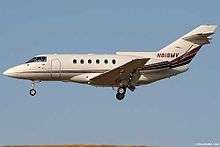East Coast Jets Flight 81
 N818MV, the aircraft involved in the accident, seen here landing at Philadelphia International Airport in 2007. | |
| Accident | |
|---|---|
| Date | July 31, 2008 |
| Summary | Crash during go-around attempt after landing, Pilot Error |
| Site | near Owatonna Degner Regional Airport |
| Aircraft | |
| Aircraft type | Hawker 800 |
| Operator | East Coast Jets |
| Registration | N818MV |
| Flight origin | Atlantic City International Airport, Atlantic City, New Jersey |
| Destination | Owatonna Degner Regional Airport, Owatonna, Minnesota |
| Passengers | 6 |
| Crew | 2 |
| Fatalities | 8 |
| Survivors | 0 |
East Coast Jets Flight 81 was a business jet flight operated by East Coast Jets, that crashed on July 31, 2008 while attempting a go-around at Owatonna Degner Regional Airport near Owatonna, Minnesota, killing all eight passengers and crew on board. The flight originated in Atlantic City International Airport, and was scheduled to land in Owatonna. The crew made a go-around attempt after the aircraft touched down, but it overran the runway, hit Approach Lighting System fixtures, stalled and crashed, with the main wreckage coming to rest 2,400 ft (730 m) from the runway end.
Aircraft
The aircraft operating the flight was a Hawker 800 registered as N818MV, manufactured in 1991. East Coast Jets began operating it in June 2003.[1](p8)
Flight
After first travelling from its base airport at Lehigh Valley International Airport[2] to Atlantic City to pick up passengers, East Coast Jets Flight 81 departed from Atlantic City International Airport at 8:13 am, en route to its destination, Owatonna Degner Regional Airport in Minnesota.[3] `
Accident

At 9:45 am, Flight 81 was cleared for landing, and the aircraft touched down on assigned runway 30. Noticing that there was insufficient runway length remaining for the jet to stop, the crew decided to go around. As it began to take off again, the aircraft overran the end of the runway and impacted elements of the Approach Lighting System. This caused the aircraft to bank hard to the right until it was upside down before crashing into a cornfield 2,400 ft (730 m) from the runway. Seven occupants died on impact. One survived the crash, but she died less than two hours later in a hospital.[4]
Investigation
After initially suspecting an over-run, the National Transportation Safety Board (NTSB) investigators deduced, from eyewitnesses in the airport's control tower, that the aircraft crashed due to a failed go-around.[1](px) Because the jet had no flight data recorder on board, NTSB investigators used the aircraft's cockpit voice recorder and eyewitness accounts. Because of the wet runway, the idea of possible hydroplaning was discussed, however it was ruled out later on.[1](p87) Investigators determined that the pilots hadn't begun the go-around earlier before overrunning Runway 30. The pilots failed to apply full brakes, and moved the brake handle towards the OPEN position instead of selecting the proper DUMP position during the landing. which would have safely brought the aircraft to a stop even after it overran the runway. The pilots were also criticized that they continued the attempt to go-around after overrunning the runway. The NTSB cited the pilots' error in attempting a go-around as the primary cause of the accident,[1](p89) concluding that the aircraft would have come to rest within the runway safety margins.[1](p87) The NTSB cited other contributing causes, and issued a series of recommendations.[5] [6]
Probable Cause
In the NTSB's final report, it states the following:
The National Transportation Safety Board determines that the probable cause of this accident was the captain's decision to attempt a go-around late in the landing roll with insufficient runway remaining. Contributing to the accident were, 1, the pilots' poor crew coordination and lack of cockpit discipline; 2, fatigue, which likely impaired both pilots' performance; and 3, the failure of the Federal Aviation Administration to require crew resource management training and standard operating procedures for Part 135 operators.[7]
The NTSB issued 14 Safety Recommendations as a result of this accident.[1](p90-91)
Aftermath
The six passengers were all connected with the construction of Atlantic City's gigantic Revel Casino, the city's tallest building, then under construction. They had flown to Iowa to meet with the glass-walled project's glass manufacturer.[3] Wrongful death actions were filed on behalf of the passengers' families and were settled around the same time as the NTSB's report. The casino was described by some as a "memorial" to the flight's passengers.[8]
References
- 1 2 3 4 5 6 "Crash During Attempted Go‐Around After Landing, East Coast Jets Flight 81, Hawker Beechcraft Corporation 125‐800A, N818MV, Owatonna, Minnesota, July 31, 2008" (PDF). NTSB. Retrieved 2018-06-30.
- ↑ Jim Deegan, "NTSB preliminary report issued in crash that killed Bethlehem-area pilots", The Express-Times, August 7, 2008.
- 1 2 Nick Ferraro and Tad Vezner, "8 dead after Owatonna plane crash; missing accounted for", Pioneer Press, July 30, 2008.
- ↑ "accident record". Retrieved 5 June 2017.
- ↑ Aubrey Cohen, "NTSB: Pilot in fatal crash tried go-around too late", Seattle Post-Intelligencer, April 15, 2011.
- ↑ Katz, Peter (5 July 2011). "It's better to accept a poor outcome than to create a disastrous one". Plane&Pilot. Retrieved 25 November 2017.
- ↑ Lacagnina, Mark (9 May 2011). "Too Late to Go". Flight Safety Foundation. Retrieved 6 June 2017.
- ↑ Ho Nguyen, "Atlantic City's Revel seen as memorial to 6 executives who died in plane crash", The Press of Atlantic City, April 11, 2012.
External links
| Wikinews has related news: Southern Minnesota plane crash kills eight |